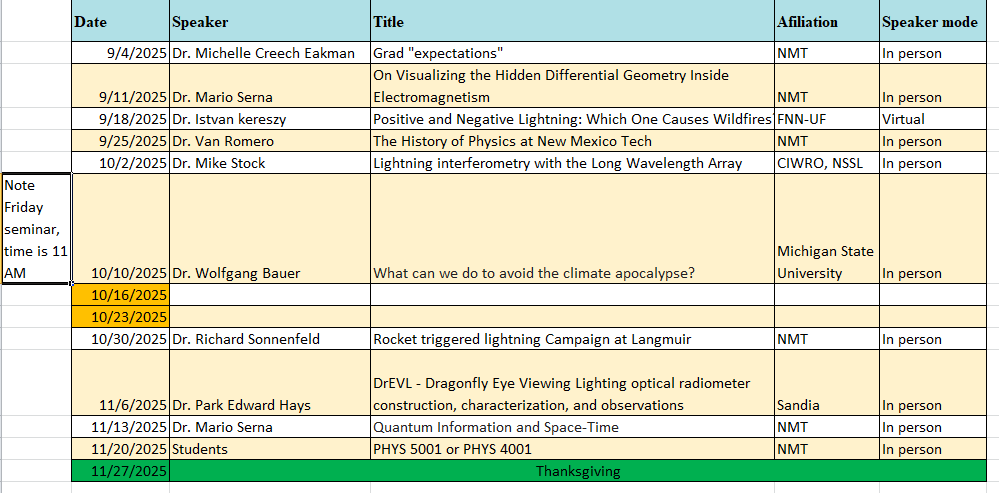Colloquium
Here is the schedule for Fall 2025

Previous abstracts of colloquia from this semester will be archived as the semester progresses.
Physics Ph.D. Defense - Shrishti Yadav.
November 18, 2025 1:00pm- 2:00pm
Location: Speare 14
Hidden Structures in Sound for Signal Detection
Signals don’t always speak loudly—sometimes they hide beneath layers of competing
sound. In this talk, I present a new approach to detecting subtle acoustic signals
that are masked by other sources in complex, mixed sound fields. Instead of filtering
or relying on known templates, I turn to tools from chaos theory—Recurrence Plots
and Poincaré Maps—to transform raw audio
into visual landscapes where hidden structure becomes visible. What’s novel is the use of multi-sensor microphone data to drive these phase space representations. By conditioning the data across multiple channels, subtle but consistent features in the signal begin to emerge—features that single-sensor methods or standard signal processing may miss. I’ll walk through the signal processing pipeline, explain how these plots are constructed, and show results from real acoustic experiments where this approach reveals signals deeply embedded in noise.
into visual landscapes where hidden structure becomes visible. What’s novel is the use of multi-sensor microphone data to drive these phase space representations. By conditioning the data across multiple channels, subtle but consistent features in the signal begin to emerge—features that single-sensor methods or standard signal processing may miss. I’ll walk through the signal processing pipeline, explain how these plots are constructed, and show results from real acoustic experiments where this approach reveals signals deeply embedded in noise.
Zoom Meeting (link here) ID: 969 5775 7925 Passcode: 051412
----------------------------------------------------------------------------------------------------
|
Physics PhD Defense - Dylan Ward
|
|
Friday Nov 7, 2025 ⋅ 2pm – 3pm
|
|
TITLE: Exploring Water Masers in the Central Molecular Zone with SWAG Abstract The inner 500 pc of our Galaxy is known as the Central Molecular Zone (CMZ) and contains a large amount of dense gas, strong magnetic fields, and energetic particles. The CMZ is an extreme environment, compared to the disk, and despite its large gas reservoir, its star formation appears to be inefficient. Understanding why star formation is suppressed here remains an open question. Maser emission provides an excellent tool for investigating these processes, offering precise high-resolution probes of both star-forming regions and late-stage stellar evolution under these unique Galactic center conditions. My dissertation uses data from the Survey of Water and Ammonia in the Galactic Center (SWAG), which is a major line imaging survey using the Australia Telescope Compact Array with a goal to map out the molecular content in the entire CMZ. The SWAG data includes the collisionally pumped 22 GHz H2O maser transition which is typically used as a tracer for phases of stellar evolution, including both young stellar objects (YSOs) and evolved stars. The SWAG survey provides data for the entire CMZ with approximately 0.9 pc spatial resolution in the Galactic center, enabling the construction of a large-scale H2O maser catalog in this unique environment. By cross-matching the SWAG detections with infrared, stellar, and other maser catalogs, I identified the likely counterparts responsible for the emission and examined how their spatial distribution relates to the underlying molecular gas, which favors positive Galactic longitudes. I also constructed maser luminosity functions for the full sample and for the YSO and evolved star subsets, comparing them with previous Galactic studies. Because star formation in the CMZ is known to be suppressed, I used the number of YSO-associated H2O masers, together with estimates of maser lifetimes and detection rates, to infer a star formation rate for the CMZ. The evolved star population was also examined by cross-matching H2O and SiO masers. This comparison provides direct measurements of stellar wind speeds, with SiO tracing inner winds and H2O probing the accelerated outflow at larger radii. I also explored how these wind speeds relate to mid-infrared colors, which reflect dust content in the circumstellar envelope. These results show that H2O masers are powerful probes of both ongoing star formation and late-stage stellar evolution in the unique environment of the Galactic center. |